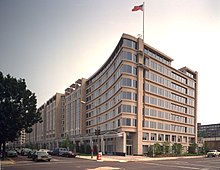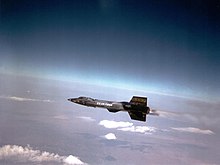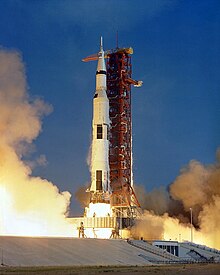NASA theme by dieharder
Download: NASA.p3t

(3 backgrounds)
 | |
 | |
| Agency overview | |
|---|---|
| Abbreviation | NASA |
| Formed | July 29, 1958 |
| Preceding agency | |
| Type | Space agency Aeronautics research agency |
| Jurisdiction | United States Federal Government |
| Headquarters | Washington, D.C. 38°52′59″N 77°0′59″W / 38.88306°N 77.01639°W |
| Bill Nelson | |
| Deputy Administrator | Pamela Melroy |
| Primary spaceports | |
| Employees | 17,960 (2022)[2] |
| Annual budget | |
| Website | nasa.gov |
| Part of a series on the |
| United States space program |
|---|
  |
The National Aeronautics and Space Administration (NASA; /ˈnæsə/) is an independent agency of the U.S. federal government responsible for the civil space program, aeronautics research, and space research. Established in 1958, it succeeded the National Advisory Committee for Aeronautics (NACA) to give the U.S. space development effort a distinct civilian orientation, emphasizing peaceful applications in space science. It has since led most of America's space exploration programs, including Project Mercury, Project Gemini, the 1968–1972 Apollo Moon landing missions, the Skylab space station, and the Space Shuttle. Currently, NASA supports the International Space Station (ISS) along with the Commercial Crew Program, and oversees the development of the Orion spacecraft and the Space Launch System for the lunar Artemis program.
NASA's science division is focused on better understanding Earth through the Earth Observing System; advancing heliophysics through the efforts of the Science Mission Directorate's Heliophysics Research Program; exploring bodies throughout the Solar System with advanced robotic spacecraft such as New Horizons and planetary rovers such as Perseverance; and researching astrophysics topics, such as the Big Bang, through the James Webb Space Telescope, the four Great Observatories, and associated programs. The Launch Services Program oversees launch operations for its uncrewed launches.
History[edit]
Creation[edit]

NASA traces its roots to the National Advisory Committee for Aeronautics (NACA). Despite being the birthplace of aviation, by 1914 the United States recognized that it was far behind Europe in aviation capability. Determined to regain American leadership in aviation, the United States Congress created the Aviation Section of the U.S. Army Signal Corps in 1914 and established NACA in 1915 to foster aeronautical research and development. Over the next forty years, NACA would conduct aeronautical research in support of the U.S. Air Force, U.S. Army, U.S. Navy, and the civil aviation sector. After the end of World War II, NACA became interested in the possibilities of guided missiles and supersonic aircraft, developing and testing the Bell X-1 in a joint program with the U.S. Air Force. NACA's interest in space grew out of its rocketry program at the Pilotless Aircraft Research Division.[4]

The Soviet Union's launch of Sputnik 1 ushered in the Space Age and kicked off the Space Race. Despite NACA's early rocketry program, the responsibility for launching the first American satellite fell to the Naval Research Laboratory's Project Vanguard, whose operational issues ensured the Army Ballistic Missile Agency would launch Explorer 1, America's first satellite, on February 1, 1958.
The Eisenhower Administration decided to split the United States' military and civil spaceflight programs, which were organized together under the Defense Department's Advanced Research Projects Agency. NASA was established on July 29, 1958, with the signing of the National Aeronautics and Space Act and it began operations on October 1, 1958.[4]
As the United States' premier aeronautics agency, NACA formed the core of NASA's new structure by reassigning it its 8,000 employees and three major research laboratories. NASA also proceeded to absorb the Naval Research Laboratory's Project Vanguard, the Army's Jet Propulsion Laboratory (JPL), and the Army Ballistic Missile Agency under Wernher von Braun. This left NASA firmly as the United States' civil space lead and the Air Force as the military space lead.[4]
First orbital and hypersonic flights[edit]

Plans for human spaceflight began in the U.S. Armed Forces prior to NASA's creation. The Air Force's Man in Space Soonest project formed in 1956,[5] coupled with the Army's Project Adam, served as the foundation for Project Mercury. NASA established the Space Task Group to manage the program,[6] which would conduct crewed sub-orbital flights with the Army's Redstone rockets and orbital flights with the Air Force's Atlas launch vehicles. While NASA intended for its first astronauts to be civilians, President Eisenhower directed that they be selected from the military. The Mercury 7 astronauts included three Air Force pilots, three Navy aviators, and one Marine Corps pilot.[4]

On May 5, 1961 Alan Shepard became the first American to enter space, performing a suborbital spaceflight in the Freedom 7.[7] This flight occurred less than a month after the Soviet Yuri Gagarin became the first human in space, executing a full orbital spaceflight. NASA's first orbital spaceflight was conducted by John Glenn on February 20, 1962, in the Friendship 7, making three full orbits before reentering. Glenn had to fly parts of his final two orbits manually due to an autopilot malfunction.[8] The sixth and final Mercury mission was flown by Gordon Cooper in May 1963, performing 22 orbits over 34 hours in the Faith 7.[9] The Mercury Program was wildly recognized as a resounding success, achieving its objectives to orbit a human in space, develop tracking and control systems, and identify other issues associated with human spaceflight.[4]
While much of NASA's attention turned to space, it did not put aside its aeronautics mission. Early aeronautics research attempted to build upon the X-1's supersonic flight to build an aircraft capable of hypersonic flight. The North American X-15 was a joint NASA-U.S. Air Force program,[10] with the hypersonic test aircraft becoming the first non-dedicated spacecraft to cross from the atmosphere to outer space. The X-15 also served as a testbed for Apollo program technologies, as well as ramjet and scramjet propulsion.[4]
Moon landing[edit]

Escalations in the Cold War between the United States and Soviet Union prompted President John F. Kennedy to charge NASA with landing an American on the Moon and returning him safely to Earth by the end of the 1960s, and installed James E. Webb as NASA administrator to achieve this goal.[11] On May 25, 1961, President Kennedy openly declared this goal in his "Urgent National Needs" speech to the United States Congress, declaring:
I believe this Nation should commit itself to achieving the goal, before this decade is out, of landing a man on the Moon and returning him safely to Earth. No single space project in this period will be more impressive to mankind, or more important for the long-range exploration of space; and none will be so difficult or expensive to accomplish.
Kennedy gave his "We choose to go to the Moon" speech the next year, on September 12, 1962 at Rice University, where he addressed the nation hoping to reinforce public support for the Apollo program.[12]
Despite attacks on the goal of landing astronauts on the Moon from the former president Dwight Eisenhower and 1964 presidential candidate Barry Goldwater, President Kennedy was able to protect NASA's growing budget, of which 50% went directly to human spaceflight and it was later estimated that, at its height, 5% of Americans worked on some aspect of the Apollo program.[4]

Mirroring the Department of Defense's program management concept using redundant systems in building the first intercontinental ballistic missiles, NASA requested the Air Force assign Major General Samuel C. Phillips to the space agency where he would serve as the director of the Apollo program. Development of the Saturn V rocket was led by Wernher von Braun and his team at the Marshall Space Flight Center, derived from the Army Ballistic Missile Agency's original Saturn I. The Apollo spacecraft was designed and built by North American Aviation, while the Apollo Lunar Module was designed and built by Grumman.[4]
To develop the spaceflight skills and equipment required for a lunar mission, NASA initiated Project Gemini.[13] Using a modified Air Force Titan II launch vehicle, the Gemini capsule could hold two astronauts for flights of over two weeks. Gemini pioneered the use of fuel cells instead of batteries, and conducted the first American spacewalks and rendezvous operations.
 <
<
